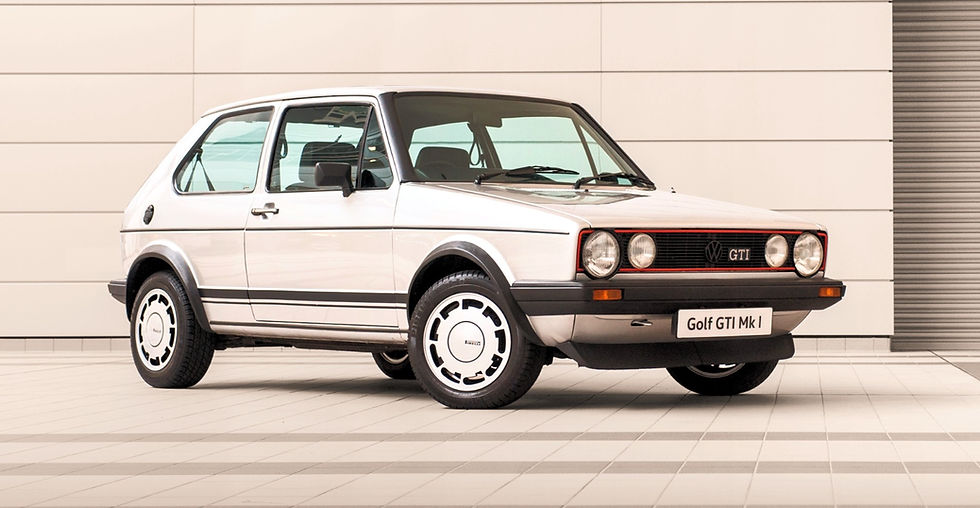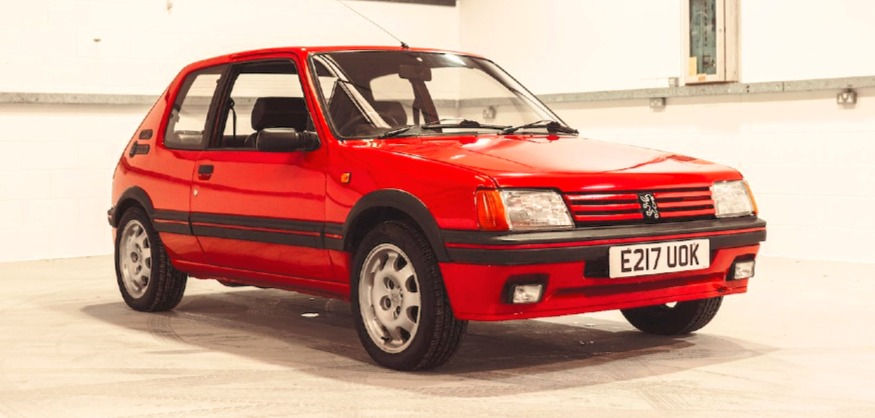Legacy of the Hot Hatch
- Colin Cumming

- Mar 12, 2024
- 7 min read

Many of us have grown up with them and watched them mature. They’ve been among us for generations, oozing charm and joie de vivre. So, is it any wonder the UK’s fascination has transformed it into cult status? I am, of course, talking about the incomparable “hot hatch.”
It comes as no surprise to learn that the UK is one of the world’s biggest markets for performance hot hatches. Looking back at their history and some fantastic vehicles that have produced the legacy, it’s easy to see why they’re held in such high regard. It's challenging to create a definitive list; however, here are some from manufacturers and models that have had an impact on the world of hot hatches.

Styled by renowned Italian automotive designer Giorgetto Giugiaro, the Alfa Romeo Alfasud is slightly lesser known, but it’s considered by many to be the first proper hot hatch. Making its debut in 1971 at the Turin Motor Show, the front-wheel drive had a boxer 1.2-litre water-cooled powertrain, which helped its aerodynamic profile and bonnet line in turn creating a low centre of gravity and excellent road holding. It had a quirky trait, if a little unorthodox, in that two-column stalks operated its lights, indicators, horn, wipers and heaters. Between 1972 and 1983, more than 900,000 cars were produced, with another 120,000 being produced for the coupe variant. The Alfasud was eventually superseded by the Alfa Romeo 33, which went on to sell over a million models. Alfa Romeo continued to set the competitive bar for hot hatches throughout the 1980s.

It’s no secret that the Volkswagen Golf GTI Mk1 profoundly impacted the hot hatch market when it was released. It’s safe to say it positively defined the era and put hot hatches on the map. The prototype, based on a Scirocco rather than the Golf, debuted in March 1975 at the Frankfurt Motor Show before being launched in 1976. Grabbing the headlines, the family car was both practical and sporty. Its success was felt across the automotive world, so much so that it spawned a swathe of imitators. To distinguish itself from the regular Golf, the GTI had some external changes, including black plastic wheel arches, a matte-black frame around the rear lights, a red frame on the front grille and ventilated front brake discs. The GTI was powered by a 110PS, fuel-injected 1.6-litre petrol powertrain, with a 4-speed manual transmission, 0-62mph in 9.2 seconds and a top speed of 113mph. A 5-speed manual became standard in 1979. A generation of ‘boy racers’ were born on the back of the Golf GTI. The success of the GTI continues to this day with the current eighth-generation model, which continues the GT tradition.

The Lancia Delta debuted in 1979; however, it wasn’t until 1983 that the performance-oriented Delta HF was launched. The HF acronym stands for ‘high fidelity’ and has been applied to sports and racing variants of Lancia’s since 1966. By the 1980s, rally car influence could be seen across the hot hatch sector, none more so than with the Lancia Delta HF Integrale. The Integrale infused a road car with a rally car, combining the latest technology with speed and agility, enabling its namesake to dominate World Rally Championships for many consecutive years. The eight-valve, front transverse 2.0-litre fuel-injected, four-cylinder powertrain incorporated a five-speed manual 4WD system with a large intercooler turbocharger, which helped boost power output to 182hp. Later models saw more powerful powertrains, enhanced torque and aesthetic tweaks implemented. There’s no denying the Lancia’s popularity. Its domination in the rally world is the stuff of legend.

Following the success of their Renault 5 Alpine/Gordini, Renault decided to shake things up and brought out the Renault 5 Turbo in January 1980. Designed primarily as a rally car – to take on Lancia’s winning Stratos and subsequent Delta HF, Renault decided to make a street version available too. The Renault 5 Turbo featured a turbocharged powertrain behind the driver, creating a mid-engine hot hatch. In a change to the norm, it was a rear-wheel drive rather than a front-wheel. Though it was a modified Renault 5, the Turbo was different – the most obvious being it was a rear-wheel drive and rear-mid engined instead of front-wheel and front-engined. The 1.4-litre, turbocharged, in-line four-cylinder engine delivered 158hbp. At the time of its launch, the Renault 5 Turbo was the most powerful French production car ever made. The Renault 5 Turbo was a force to be reckoned with.

Many questions were asked when Ford dropped their prestigious RS badge in 1980. However, to compete with Volkswagen’s Golf GTI, Ford quickly replaced the RS with the XR suffix, which was a massive marketing success. Ford developed a hot hatch version of the Mark III Escort. Initially called an XR3, it featured a 1.6-litre powertrain with uprated suspension and cosmetic tweaks but lacked a five-speed manual and fuel injection. When fuel injection and the five-speed manual finally arrived in October 1982, the XR3i was created. The front-wheel drive XR3i produced 104bhp with 138 Nm (101 lb-ft) of torque at 4800rpm, and with stiffened suspension, better road holding and ride comfort, the XR3i was on the wish list of many. Disc brakes at the front and drums at the back only helped cement the XR3i into automotive history. With a production run from 1982-1986, the XR3i brought fun to millions, alongside its younger sibling, the XR2.

The Astra GTE Mk1 was Vauxhall’s first official hot hatch, marking their first foray into the new growing sector. The two-door GTE was based on the 1980 Mk1 Astra. With a 1.8-litre, in-line four-cylinder petrol powertrain, delivering 115bhp, 0-62mph in 8.5 seconds and a top speed of 115mph, the GTE was faster, bigger and more powerful than its nearest rival, the Golf GTI. The GTE wasn’t just about power; its dynamics were highly acclaimed. Its broader and lower profiles aided handling with revised damping absorbing the road, and its close-ratio gearbox made it a driver’s car. With responsive steering, race-like ride quality and impressive handling, Vauxhall knew they were onto a winner. The white 1800 Astra GTE was the first car in the UK to be ‘colour coded’, with trim matching the base colour of the car. Wheel arches, front, side and lower skirts, mirrors, bumpers, and alloys were all painted white. Vauxhall’s first venture into the world of hot hatches certainly wouldn’t be their last.

A firm favourite in the 1980s, with French flare and joie de vivre, was the Peugeot 205 GTI. Launched in 1983, the Peugeot 205 was an instant hit, taking on the competition, and in doing so, it created one of television’s most memorable car commercials. It wasn’t until 1984 that the GTI arrived, making an impact with its 1.6-litre 105bhp petrol powertrain. The new GTI quickly found its feet. 1987 saw a 10bhp increase to the 1.6-litre and a new 1.9-litre, 128bhp. Besides the model's engine differences, the 1.9-litre had half-leather seats, all-around disc brakes, and 15-inch alloys. Despite its huge success across Europe, Peugeot never exported the car to the US, though car enthusiasts imported many. Thanks to its handling, nimbleness, and fun factor, the 205 GTI was a true hot hatch in every sense of the word. Due to its vast success, industry insiders subsequently named it the ‘car of the decade’.

1993 saw the launch of the formidable Renault Clio Williams – named after the then Renault-powered Williams F1 team. With an initial run limited to just 3,800 cars, they sold out instantly, forcing Renault to quickly build a few thousand more to keep up with demand. Each model was fitted with their own unique numbered plaque on the dash. Due to demand for the first series, Renault built the Williams 2 and 3 models, with more than 12,000 being built. The iconic 449 Sport Blue paint with gold alloys gave the Clio Williams a distinctive appearance. The Clio Williams had a multipoint fuel injection, inline-four 2.0-litre 16-valve powertrain, delivering 145bhp and 4,500 rpm of torque. Top speed was a respectable 134 mph. Due to its popularity, it also made a name for itself in the world of rallying by being a common sight on the circuits, as well as an official Formula One safety car. Since the Williams edition, the Clio has been one of Renault’s biggest selling cars in Europe ever since.

When Citroën launched their Saxo model in 1996, it came with three sports models, the top-of-the-range being the VTS. The supermini took the hot hatch world by storm. With 120bhp, the hot hatch became the definitive machine of a generation (helped by Citroën (perhaps foolishly) giving away free insurance). Powered by a 1.6-litre, 16-valve, 0-62mph, it was in 7.8 seconds and had a top speed of 127mph. With rear disc brakes, ABS as standard and 5-speed manual, the VTS had a relatively lightweight chassis, snappy steering, stiffer suspension, sportier seats and sported a sharp body kit and alloy wheel combination – all attributes for making it the perfect hot hatch. The once slight and delicate Saxo looked broad, muscular, and menacing; on the plus side, it was a fun car to drive. To this day, the VTS is held in high regard by many. Citroën hasn’t yet surpassed its legacy, as this little French car broke the mould.

Launched in 1997, the Honda Civic Type R was the third model to sport Honda’s ‘Type R’ badge (the NSX and Integra preceded it). The Civic Type R model is the highest-performing version of one of the longest-running production cars of all time. The iconic red background on the badge helped to differentiate its sporting pedigree. With a lighter body, tuned engine, and upgraded chassis, the Honda Civic Type R took the hot hatch world by storm. The Japanese model quickly found its feet and started to take on its German counterparts – establishing a loyal following. The first generation boasted a 183bhp, 1.6-litre petrol powertrain which could rev up to 8,200rpm. Its famous red interior has lasted throughout all incarnations, highlighting its distinctive traits. The Type R B16B engine boasts one of the highest power outputs per litre of all time. The first-generation Civic Type R was a rare breed because this hot hatch was only officially sold in Japan, though models unsurprisingly very imported globally. It wasn’t until the second generation in 2001 that the UK market witnessed history being made.
The world of hot hatches is always subjective. However, if the above models don’t help whet your appetite for driving pleasure, I don’t know what will.




Comments